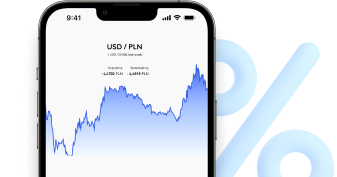Exchange rate THB - Thai baht
Thai baht - The official currency of Thailand. One baht divides into 100 satang. The history of the Thai baht is related to the coins from the period of the Kingdom of Sukhothai.
Select currencies and check rates
Live rates.
Update: 30s
| Currency | Buy | Sell | Name | Currency code |
|---|---|---|---|---|
| THB EUR | 0.0238 | 0.0307 | Thai baht | 1 THB |
Thai baht exchange rate - chart
Last currency comments
Over 900 000 reviews
Customers rate us 4.9/5.0.*
Start saving today
Forget about unfavourable rates and hidden fees. See how much you can save. Create a free account and start converting currency online.
Open account for freeThai baht
Thai baht is the official currency of Thailand. It is denoted by the international abbreviation THB and also by the symbol ฿ in settlements. It is divided into 100 satang.
The Thai baht - where is it used?
The Thai baht is the formal monetary unit of only one country - Thailand. So, choosing this exotic country as a vacation destination, it is worth checking the baht exchange rate, and more specifically - the currency pairs THB/EUR and THB/USD.
The history of the Thai baht
The Thai baht, like the British pound, is derived from a unit of weight. It was used as early as the Sukhothai kingdom, which had its origins in the XIII century. It was nothing more than a carefully measured unit of silver (about 15 grams). People living in the area of present-day Thailand used this accounting system until 1897 when the decimal system was introduced. At that time, the Thai baht was divided into 100 satang. Until 1902 the value of a baht was closely related to 15 grams of silver. The baht exchange rate was also fixed top-down to currencies such as the pound sterling, the Spanish dollar and the Indian rupee. During World War II, the baht was pegged to the Japanese yen at a rate of 1:1. Gold convertibility was also established, with 1 THB representing the value of 0.25974 grams of pure gold. After the war, until 1978, the Thai baht was pegged to the US dollar. At the end of that period, the US dollar cost 20 baht. The baht exchange rate was also pegged to the USD from 1984 to 1997. The Asian financial crisis during the late 20th century plunged the Thai currency. The Thai baht's value against the dollar fell by more than half at the time.
Thai baht - key information
Thai baht is available in coins of 1, 5, 10, 25 and 50 satang, as well as 1, 2, 5 and 10 baht. All of them depict the portrait of the current King of Thailand, Maha Vajiralongkorn, on the obverse. The reverse, on the other hand, contains the royal monogram. Due to the scarce variety, the coins can be difficult to distinguish for foreigners - they differ mainly in colour. The Thai baht banknotes come in denominations of 20, 50, 100, 500 and 1,000 baht. As with the coins, the obverse features the image of the current king. The reverse bears portraits of previous Thai kings. When going to Thailand, it is worth remembering to handle money properly and with respect. Since they bear the king's image, even crushing a banknote may be considered an insult, which can be punished with imprisonment.
Check THB exchange rate
Interest in the THB exchange rate increases, especially during the holiday season. Tourists, planning an adventure trip to exotic Thailand, monitor THB/USD or THB/EUR pair quotations, hoping for the most attractive exchange rate. Exchanging Thai baht at a stationary exchange office can be difficult, so it is advisable to do it online, using our portal. There you can also find current THB/EUR exchange rates. Alternatively, one can take US dollars to Thailand and exchange them on the spot, although, in this case, tourists are exposed to the costs of double currency conversion.






























